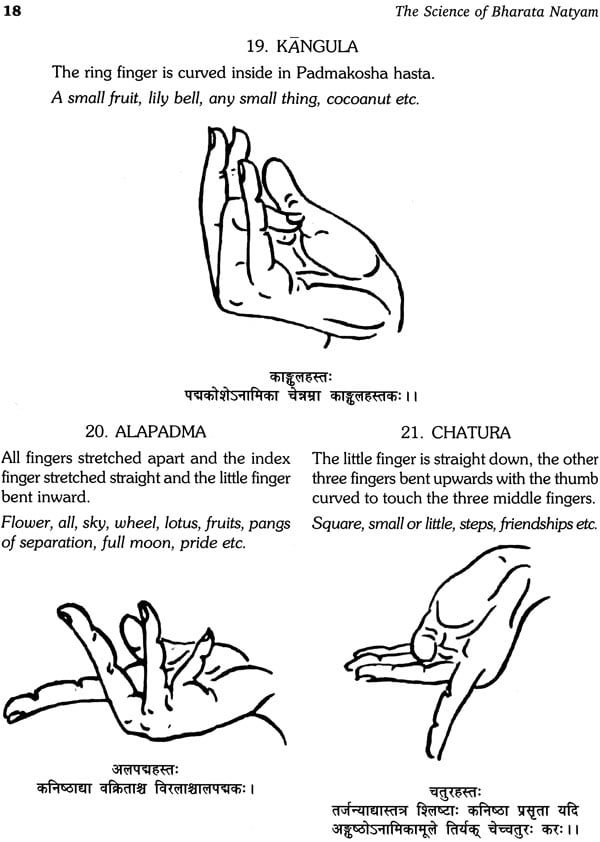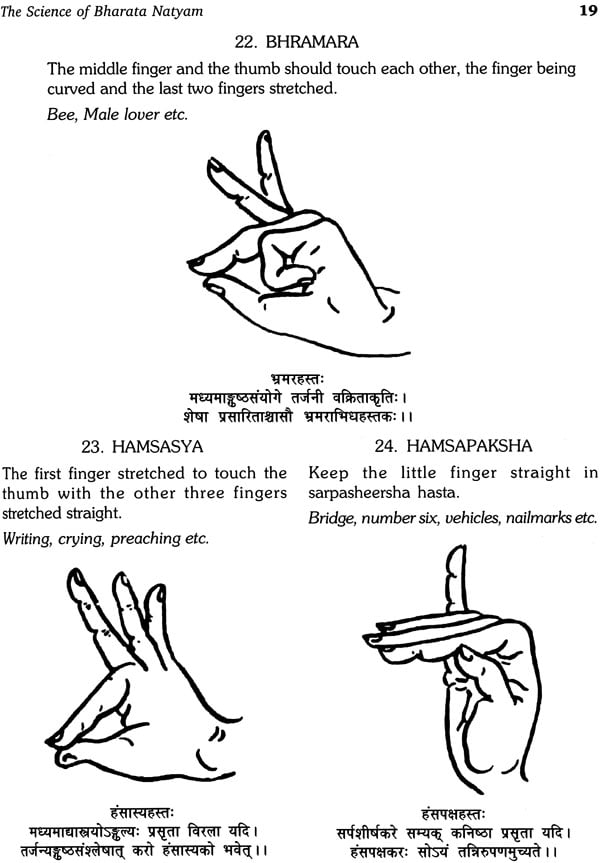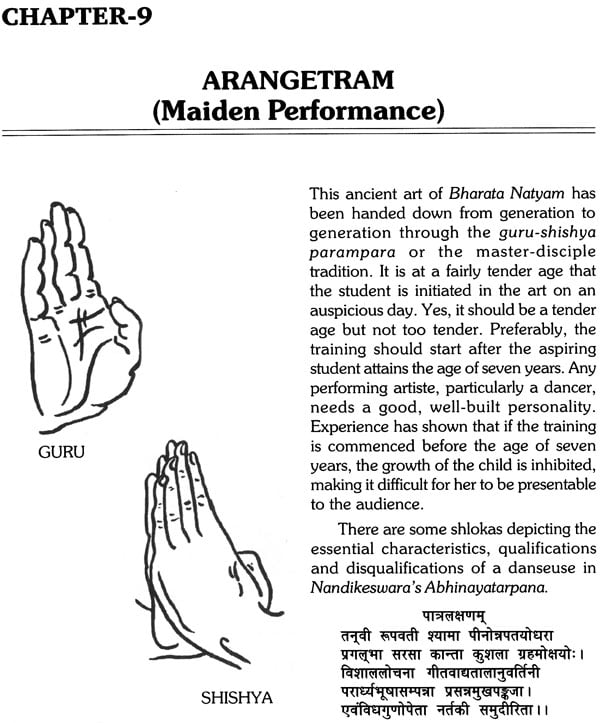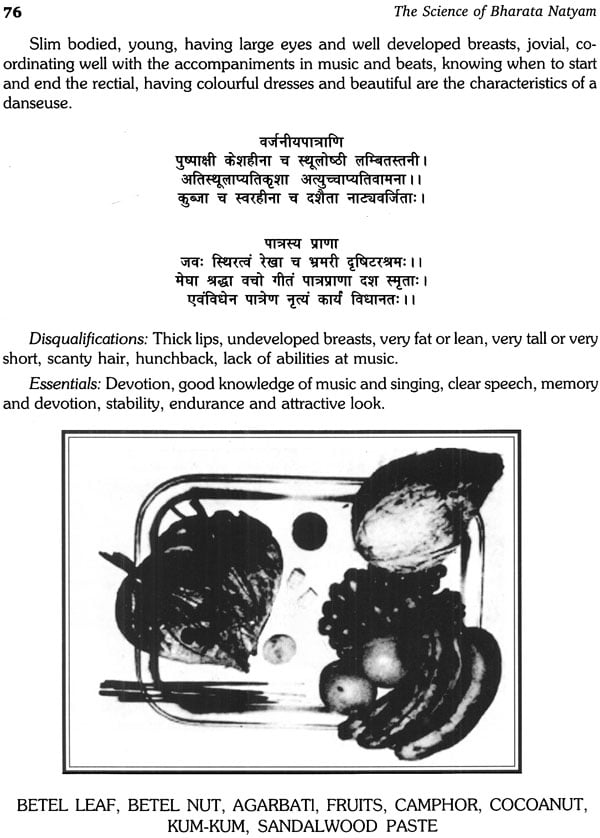
The Science of Bharata Natyam
Book Specification
| Item Code: | NAL173 |
| Author: | Saroja Vaidyanathan |
| Publisher: | Kanishka Publishers |
| Language: | English |
| Edition: | 2015 |
| ISBN: | 9788173913884 |
| Pages: | 108 (Throughout B/W Illustrations) |
| Cover: | Hardcover |
| Other Details | 10 inch x 7.5 inch |
| Weight | 460 gm |
Book Description
The Science of Bharata Natyam is an authentic explanation of the origin of the art and its elements like adavu (footwork), hasta (hand gestures), bheda (movements of the head, the neck and the eyes), abhinaya (expressions), tala (rhythm), costume and jewellery, musical instruments used for Bharata Natyam and arangetram (maiden performance) with sketches, diagrams, tables and photographic illustrations. Also included in the volume are a diagrammatic representation of the elements of Bharata Natyam and a glossary of the terms used in this fine art.
Saroja from a very tender age of seven years trained under the accomplished Guru Lalitha of Saraswati Gana Nilayam, is the third generation (Paramapara) disciple of the famous Guru Kattumannar Muthukumaram Pillai of Thanjavur, Tamil Nadu. She has also undergone training in Carnatic Music under Prof. P. Sambamoorthy at the Madras University. Saroja is one of the India’s prominent Bharatanatyam exponents earning her fame as an intelligent and innovative choreographer. Established a fine art institution Ganesa Natyalaya in 1974 in Delhi with its own premises.
She travelled in India and abroad for Recitals, Lecdems and workshops. Published four art books in dance and music. Compiled an Encyclopedia on Bharatanatyam for NCERT. Appreciated by the audience and the press. Built a Kathak School in Bhagalpur in Bihar “ Sharadha Sangeet Sadan” in 1972.
As a member- esteemed member of several renowned organizations including Ministry of Culture, ICCR, SKP, IGNOU and IKSVV (India Kala Sangit Vishwavidyalaya) Chattisgarh.
Chairperson of National Institute for the visually Handicapped (Government of India). Choreographed and Directed a Bharatanatyam Cultural Segment for Queen’s Baton Relay and XIX Commonwealth Games Opening Ceremony
Awards-In addition to several prestigious awards the recipient of Padmashri and Padma Bushan from Government of India, Delhi State award from S. K. P., Kalimamani from Government of Tamil Nadu, Sangeet Nataka Akademi award from Sangeet Natak Akademi, Kalidas Samman from Government of Madhya Pradesh, D. Litt from IKSVV (Khairagarh) Vayo Sreshta Samman Award from Government of India, Ambassador of Place by IIFWP and Kalpana Chawla Excellence Award. Fellowship from Department of Culture, Government of India for” Aharya Abhinaya”
Compiled and Produced DVD, based on the fundamentals and nuances of Bharatanatyam, an educative and entertaining capsule for an hour, in 2014.
Bharata Natyam as an art form has seemed to me to embody the whole gamut of Indian expression in all its richness, its variety, and its nuances. The fact that it has emerged through two thousand years of history with its purity and transcendental quality is tribute to its inherent vitality.
Over the last few decades it has attracted many a dedicated practitioner who has preserved its essence and enriched its content. Saroja Vaidyanathan is one such votaty. Her untiring zeal in propagating the art and science of Bharata Natyam is renowned. In this book, aptly titled ‘ The Science of Bharata Natyam’ ,Smt. Vaidyanathan explains in lucid language and clear cut line drawings the technical elements that go to make this magnificent dance form.
Bharata Natyam is a dance that commands the intricacies of a science and infuses these with the imagination and depth of an art. The book, I am sure, will be equally useful to the layman and intiate at home and abroad.
The present book is an outcome of several years of research into the theory and practice of Bharatanatyam. Being the third generation of guru-shishya parampara of Tanjavur, Kattumanner Muthukumara Pillai and a direct disciple of Guru K. Lalitha, I have received rigorous training in Bharatanatyam. I have also been trained in Karnatic Music under Prof. P. Sambamurthi at the University of Madras. With the experience of fifty five years as a performing artiste, Guru, and the Founder of Ganesa Natyalata, a leading institute of classical dance, I could perceive the vista of the origin and the progress of Bharatanatyammin all its splendour and glory. The art may be compared to the ocean or to cosmos; the deeper one goes into it, the more there is to comprehend and appreciate. Similarly there is no limit to the scope for innovation within the grammar of Bharatanatyam.
During my recitals-demonstrations, and classes, I discovered a deep desire for a comprehensive understanding of this art amongst both connoisseurs and students, regardless of their individual cultures. In this book, therefore, I have attempted to provide an insight into the several aspects of Bharatanatyam, complete with illustrations and diagrams, to assist the reader on the long and exciting journey of appreciation of the art.
I owe my gratitude to my Gurus, my parents and my family, without whose support and assistance; it would not have possible for me to accomplish this task.
Culture is a portmanteau expression indicating a fusion of several aspects that condition and are in turn conditioned by the life and civilisation of the people. Culture is what distinguishes the different peoples of the world. It includes religion, language, attire, attitudes, painting, music, dance, other performing arts and a host of other things. As an essential aspect or ingredient, dance helps identify the culture, taste and attitude of the people. In a large multi-lingual country like India, culture would not represent a single unified set of values or ideas but would indeed be multi-dimensional in character depending on the cross fertilization of ideas, values and systems obtaining in the different parts of the country. That is why, it is said that India and Indian culture are examples par excellence of unity in diversity. It would not be an exaggeration to say that Bharata Natyam occupies a prominent position in the Indian cultural profile. One has to go to the remote past to trace the origin of this form of fine art which is inextricably associated with religion and mythology. Bharata Natyam emanated in the southern part of India; The temple carvings and sculptures bear ample testimony to this assertion. Temples, apart from being places of worship, provided in the ancient days the forum for socio-cultural interaction of the people. With their vast courtyards and halls, the temples became the natural venue in the southern part of India where cultural programmes used to be held, the illumination being provided by huge oil lamps. For reasons not clearly known, dance became the exclusive preserve of devadasis. The expression devadasi literally means God’s attendant or devotee. Devadasis, therefore, came to be attached to particular temples and it was their duty to give recitals in praise of the presiding deity of the temple. This would partly explain the religious and mythological base of Bharata Natyam. For a long time, it was commonly known as Sadir or Sadir-attam in Tamil and was patronised by Maharajahs and Zomindars. It is not necessary to dwell on the vicissitudes through which Bharata Natyam went. Suffice it to say that thanks to the sustained efforts of enlightened art lovers and social workers, this fine art was restored to its pristine glory and status and it regained the respectability that it has been enjoying since the last forty years or so. Youngsters of respectable families evinced considerable interest and started learning Bharata Natyam and there is hardly any part of India at present where Bharata Natyam as a dance form is not known, taught or performed; it is popular even internationally.
If exactness is the hallmark of science, Bharata Natyam may indeed be described as science amongst the performing arts. It is exact in the sense that it places equal emphasis on the different aspects that go to make a dance, namely, Bhava (expression), Raga (melody) and Tala (rhythm). Natyam in Tamil means dance and the prefix Bharata is commonly explained as an acronym composed of the first letters of Bhava, Raga, and Tala. There is also a theory that Bharata Muni laid down the first principle of this form of dance and hence it is called Bharata Natyam.
According to Bharata Muni and others, Nritta, Nritya and Natya are the three aspects of dance.
Performing arts were classified as nritta, nritya and natya in our ancient classics. Nritta refers to the pure form of dance comprising foot-work and the movements of limbs, neck, head etc. the nritta conforms to the rhythm or beat or tala and is intended to be a delineation of graceful and artistic movements. It does not, however, seek to convey any meaning. The nritta is, therefore, performed either to the utterance of the jati, korvai, teermanams etc. or to the singing of simple notes or swara combinations which are repeated a number of times. Alarippu, jatiswaram and tillana fall under this category.
Nritya places the emphasis on abhinaya (facial expression) and gestures to convey certain meaning or massege. The combination of abhinaya and nritta is called nritya. Sabdam, varnam and padam may be classified as nritya.
Natya denotes the drama form a performing art comprising abhinaya, gestures and dialogue or spoken words which could be easily followed by the audience. In a sense, Lord Shiva’s tandava dance may be taken to be the first form of nritta and Parvati’s lasya, the origin of nritya.
Puranas have it that Lord Shiva danced sixteen varieties of cosmic dance including the Ananda Tandava. From His small damaroo (drum), kinkini and other attributes, flowed the grammar and nuances of the dance which Lord Brahma imbibed. And, Lond Brahma took the compositions of Rig Veda, the expressions of Yajur Veda, the music of Sama Veda and the rasa of Atharva Veda and synthesised them with the dance to form the Shartra. Nandikeshwara was inspired by the Shastra and passed it on to Bharata Muni. When he codified this dance form and presented it before Lord Shiva, He felt that this form of dance could best be rendered by females, whereupon His consort Parvati pleased Lord Shiva by performing the dance. It is also interpreted that whereas Lord Shiva gave the nritta, it was Parvati who embellished it with lasya and the two namely nritta and lasya were constituted by Bharata Muni into a dance form and hence it is called Bharata Natyam. The point that it synthesises the best elements of the four Vedas raises it to the position of the fifth veda.
Science and technology which have made life easy in practically every respect have benefitted the performing arts too. The oil lamps, romantic as they were, have given way to electric light. The singer does not have to strain her vocal cords as much as one had to in the olden days. The microphone and the loudspeakers carry the voice of the singer to the farthest corners of the assembly. The dancer does not have to dance on the stone floor any longer; the stages are now provided with smooth wooden floor. With the provision of such modern facilities, it has become possible for the artiste to make innovations without exceeding the limits of the grammar of Bharata Natyam.
The introduction of ballet or dance-drama is one such innovative effort. The ballet, being a beautiful synthesis of the elements of Nritya and Natya, has been adopted as a convenient and colourful form of presenting epics in the dance form. A solo dancer has a certain freedom of execution of the dance while a ballet calls or a high degree of synchronisation of movements without letting them appear mechanical. Choreographing a ballet requires a lot more of attention to details and demands greater skills and perception. Even the selection of artistes to portray the different characters in a ballet has to be done with plenty of care.
Bharata Natyam as an art had been highly developed even 2000 years ago. Its theory and practice had been systematised and codified in elaborate treatises like Bharata’s Natya Shastra and Nandikeswara’s Abhinaya Darpana. Yet it is not something antiquated; it is fresh and fascinating now as it was in ancient times. Neither old nor new, it is an art for eternity because of the outstanding renaissance work of tar-seeing pioneers and also because of the enduring and enthralling beauty of the art itself.
| Foreword | vii | |
| Preface | xi | |
| 1 | Introduction | 1 |
| 2 | Adavu(Foot Work) | 5 |
| 3 | Hasta-Mudra | 10 |
| Asamyuta Hastas-Samyuta Hastas | ||
| Navagraha Hastas | ||
| Dasavar Hastas | ||
| 4 | Bheda (Classification of Movements) | 32 |
| 5 | Abhinaya | 41 |
| Four Abhinayas-Angikabhinaya | ||
| Nayaki, Nayaka Lakshanas | ||
| Costumes and Omaments | ||
| 6 | Tala (Rhythm-Beat) | 47 |
| 7 | Costume and Jewellery | 53 |
| 8 | Musical Instruments | 69 |
| 9 | Arangetram (Maiden Performance) | 75 |
| Diagramatic Representation of the Elements of Bharata Natyam | 81 | |
| Ascending Steps of the Syllabus of Bharata Natyam | 82 | |
| Index | 83 |











